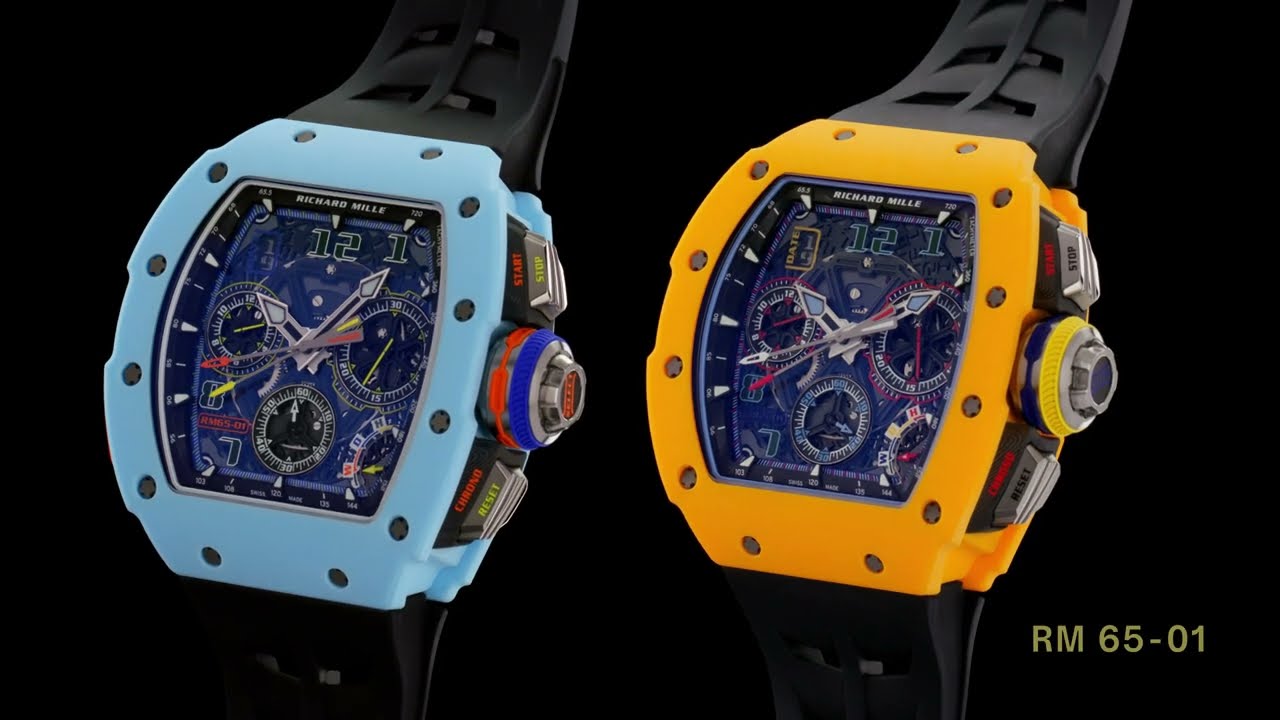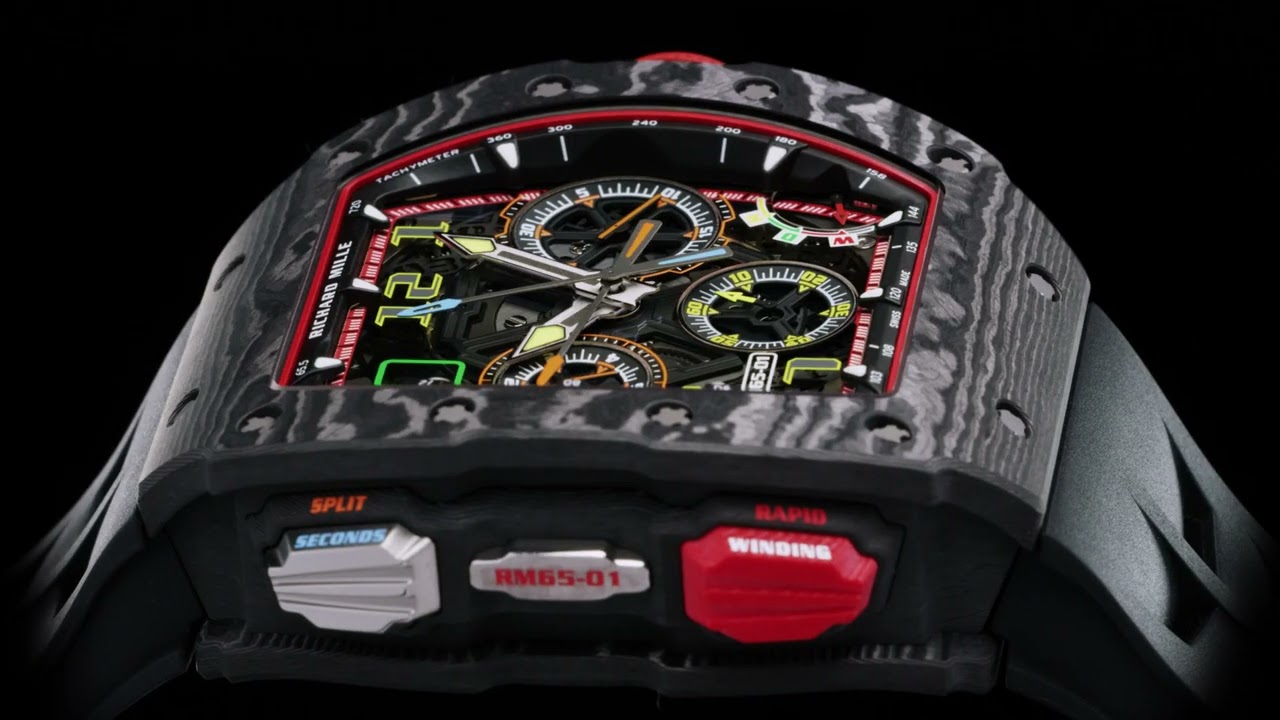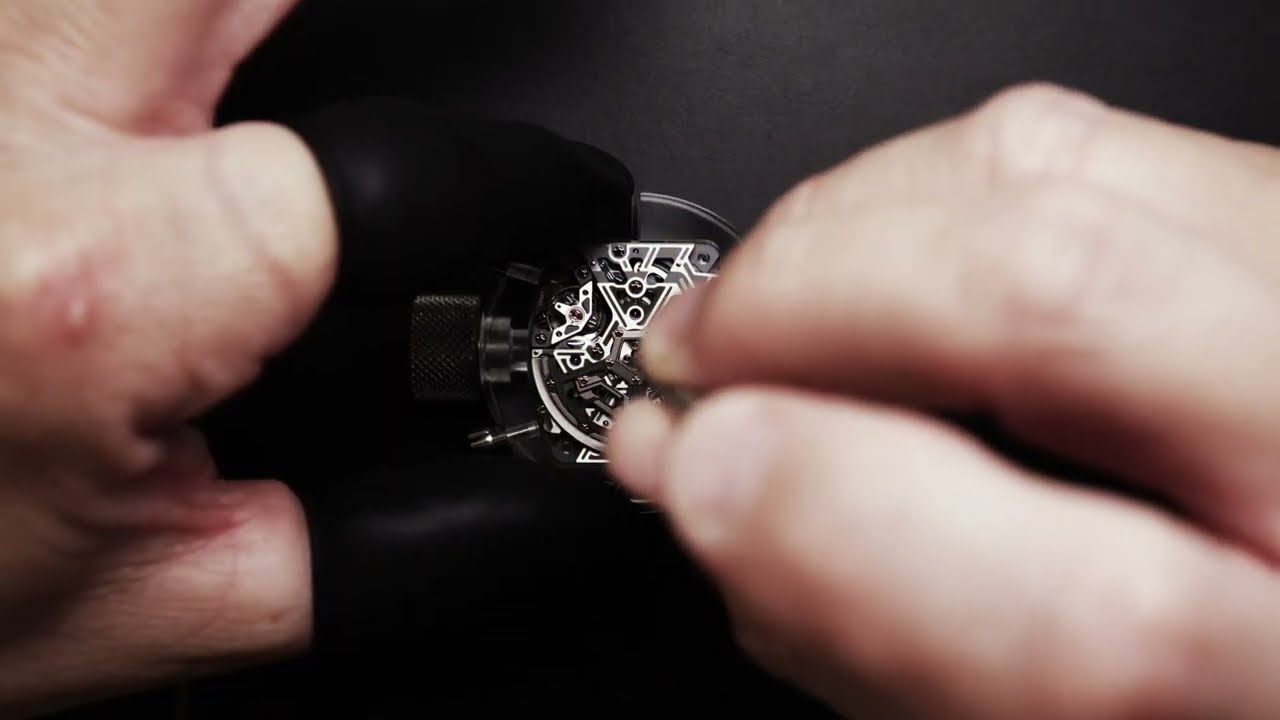• The most complex automatic watch ever from Richard Mille
• Two new versions to enhance the RM 65-01 collection

5 years of development representing a two-fold achievement: the creation of a split-seconds chronograph – the most complicated automatic winding watch that has ever come out of our workshops – and its production beyond the limited series. During its design, this high-frequency model was enhanced with a new gearcase in the form of a function selector. in the crown and a calibre’s rapid winding button. A first – the Richard Mille RM 65-01 Automatic Split-Seconds Chronograph, now also avalable in dark yellow Quartz TPT® and pastel blue Quartz TPT®


Perfect harmony is an unending quest. At Richard Mille, it’s also matter of fusion. As with a case and its calibre. Some 600 parts which, once assembled, constitute the most complex of all the brand’s automatic movements: the calibre RMAC4, which supplies the RM 65-01 Split-Seconds Chronograph with its formidably precise chronometric information.

And, right in time for summer, the existing RM 65-01 collection (red gold and Carbon TPT®, titanium, Carbon TPT®, grey Quartz TPT®) is enriched with more vivid shades. Richard Mille continues to exhibit its disruptive personality with two new versions. These evoke, respectively, azure skies and the fiery celestial orb. The first, possessing a case crafted of pastel blue Quartz TPT® will join the collection. The latter, issued in a limited edition of 120 watches, features a dark yellow Quartz TPT® whose brightness warms the pageantry of gears visible through its skeletonised dial.

The dominant colours of the dial contribute to establishing a rich chromatic palette brimming with energy. Each colour is associated with a function on the dial, thereby enhancing ease of reading, a colour code that is shared with the pushers and crown.

Equipped with a six-column wheel, the calibre RMAC4 masterfully orchestrates the measurement of time. This automatic movement possesses a high-frequency balance with variable inertia, oscillating at 36,000 vibrations per hour (vph). A pusher located at 8 o’clock makes it possible to rapidly recharge the spring of its fast-rotating barrel. The motor of this chronograph then benefits from a 60-hour power reserve. The function selector on the crown enables the wearer to switch quickly from traditional winding mode (W) to setting the semi-instantaneous date (D), or the hours and minutes (H).

The RM 65-01 Automatic Split-Seconds Chronograph in dark yellow Quartz TPT® and pastel blue Quartz TPT® promise a summer brimming with sensations and experiences.


Given its technical edge, which translates to a movement with 480 components, we knew from the beginning of its construction that the development phases would be long and complex because all the “commands” had to be scrupulously checked. But the advantage is that once stabilised, this movement is magnificently consistent. This split-seconds chronograph was subject to a battery of merciless tests that had to demonstrate its correct function in any situation
– SALVADOR ARBONA,
TECHNICAL DIRECTOR FOR MOVEMENT


This chronograph honed for the 21st century has a high frequency balance with variable inertia – 5 Hz or 36,000 vibrations per hour – for superior timekeeping accuracy over an extended period and can calculate the time to a 1/10th of a second. A genuine racing engine with a split-second hand to calculate intermediate times.

The integrated movement boasts unfailing consistency with its 6-column wheel architecture and vertical coupling. Like a mechanical brain, this castellated piece orchestrates the controls and can be seen through the base. A mechanical cathedral—standing on a grade 5 titanium chassis supported by grade 5 titanium bridges—it receives its energy from a fast-rotating barrel that maintains ideal torque for energy transmission for the full duration of its 60-hour power reserve. The barrel’s automatic winding also ensures the watch sustains optimal torque whilst worn on the wrist.

The chronograph was also subjected to a battery of merciless tests to demonstrate its capacity to function under any circumstances. These included everything from shock and drop simulations to accelerated 10-year ageing phases for all functions, by way of waterproof tests and magnetic field resistance trials.

In another milestone, Richard Mille developed its first in-house patented rapid-winding mechanism, activated by a pusher at 8 o’clock. In 125 presses, the barrel is fully wound, ready to time your next event. This highly practical function, described as ‘very playful’ by Richard Mille’s engineers, was particularly difficult to develop because of its high levels of torque transfer. During the ageing tests, the function was activated thousands of times.

The model was also enhanced with a new gearbox, taking the form of a function selector housed in the crown. This system makes it possible to switch between ‘traditional’ winding (W), semi-instantaneous date adjustment (D) or setting the time (H), all by simply pressing the crown.

Quartz TPT® and Carbon TPT®, which possess remarkable damascene surfaces, are composed of layers of parallel filaments obtained from separating silica and carbon threads. Quartz fibres are generally used for very high-performance applications due to their resistance to high temperatures, their strength and their transparency to electromagnetic waves. Fibres are aligned in layers no thicker than 45 microns and saturated in a grey resin developed specially for Richard Mille. These layers are then stacked using an automatic positioning system that changes the orientation of the fibre between each layer by 45°. After being heated to 120°C and subjected to a pressure of 6 bars, they are machined on a CNC machine at Richard Mille’s manufacturing facilities. Carbon TPT® is made by an identical process, but from carbon threads.

Available in titanium, Carbon TPT®, Red Gold and Carbon TPT®, Grey Quartz TPT®, Dark Yellow Quartz TPT® and Pastek Blue Quartz TPT®.
CALIBRE RMAC4: Skeletonised automatic winding movement with hours, minutes, seconds at 6 o’clock, date, split-seconds chronograph with 30-minute counter at 3 o’clock, 12-hour counter at 9 o’clock, function selector, rapid winding and variable-geometry rotor.
Case dimensions: 44.50 x 49.94 x 16.10 mm

POWER RESERVE
Around 60 hours (±10%) without chronograph running.
Actual power reserve results will depend on the period of time the chronograph is utilised.
BASEPLATE AND BRIDGES MADE OF GRADE 5 TITANIUM
The baseplate is grey electroplasma treated and the bridges are black PVD and grey electroplasma treated. Grade 5 titanium is a biocompatible, highly corrosion-resistant and remarkably rigid alloy, which enables the gear train to function effortlessly. The alloy is 90% grade 5 titanium, 6% aluminium and 4% vanadium. This combination further increases the material’s mechanical properties, which explains its frequent use in the aerospace, aeronautics and automotive industries. The baseplate of the RMAC4 calibre has been optimised for an extremely low weight/resistance ratio.
The skeletonised baseplate and the bridges were subjected to intensive and complete validation tests to optimise their resistance capacities

SPLIT-SECONDS CHRONOGRAPH
The modern architecture of this movement enables for the consistent and rational arrangement of its constituent parts, avoiding unnecessary superimpositions and permitting the best possible use of the functions thanks to technical solutions.
The RMAC4 calibre is equipped with the latest-generation split-seconds mechanism developed by the engineers at Richard Mille. The new column wheel controls the different levers of the split seconds function and optimises the chronograph’s operation. The 6-column wheel ensures optimised simultaneous movement, maximal function locking, and greater adjustment durability.
The virtually complete elimination of initial jumping in the chronograph seconds hand and reduced energy consumption of these mechanics are the fruit of a great number of studies leading to the design and manufacture of dedicated gear wheels and levers.
SPLIT-SECONDS CHRONOGRAPH OPERATION
Use – Start or stop the chronograph function via the pusher located at 2 o’clock. The hands are reset by pressing another pusher, located at 4 o’clock.
Split-seconds chronograph function – By pressing the pusher at 10 o’clock, you can stop the split-seconds hand to read an intermediate time while the chronograph is engaged.
Pressing the pusher again allows the split-seconds hand to rejoin the chronograph hand.
30-minute totaliser – While the chronograph function is activated, the minutes passed are indicated by the subdial at 3 o’clock.
12-hour totaliser – The subdial located at 9 o’clock indicates the hours that have passed since the chronograph was started, up to a maximum of 12 hours.

FUNCTION SELECTOR
It is constructed with a highly specialised gearbox design for Winding, Date and Hand Setting functions. To shift back and forth through these different functions, use the pusher located at the centre of the crown until the desired function is selected. The hand located at 4 o’clock will indicate W, D or H accordingly.
DATE DISPLAY
Semi-instantaneous, placed in a vertical aperture at 11 o’clock.
RAPID WINDING MECHANISM
The rapid winding mechanism was developed in addition to the automatic winding and winding with the crown.
It allows the barrel to be quickly rearmed in the event the watch stops. By pressing 125 times on the pusher at 8 o’clock, you allow the barrel to be fully wound. This function is ideal for quickly rearming the watch if not worn for a long time.
HIGH FREQUENCY BALANCE WITH VARIABLE INERTIA
Beating at 5Hz (36,000 vph), the fast-beating free-sprung balance offers better reliability in the event of shocks, movement assembly and disassembly, and also guarantees better chronometric results over an extended period of time, keeping a more accurate time. This new type of balance at Richard Mille can measure accurately to 1/10th of a second, ideal for a split-seconds chronograph watch under sporting conditions.
The regulator index is eliminated, and a more accurate and repeatable adjustment is possible thanks to 4 small, adjustable weights located directly on the balance.

VARIABLE-GEOMETRY ROTOR
The RM 65-01 uses a newly designed variable geometry to optimise the rotor’s winding motion.
Rotor specifications:
– Central flange in grade 5 titanium
– Platinum weight segment
– Weight segment with 3 possible positions
– Brass wings
– Ceramic ball bearings
– Bidirectional winding system
This new and exclusive Richard Mille design makes it possible to effectively adapt rewinding of the mainspring to the user’s activity level, in sporting or non-sporting environments.
By adjusting the 3-position weight, the rotor’s inertia is modified to either speed up the winding process in the case of leisurely arm movements, or to slow it down during sporting activities. This invention allows the movement’s winding mechanism to be optimised and personalised to the owner’s lifestyle.
FAST-ROTATING BARREL (6 hours per revolution instead of 7.5 hours)
This type of barrel provides the following advantages:
– The phenomenon of periodic internal mainspring adhesion is significantly diminished, thereby increasing performance.
– Provision of an excellent mainspring delta curve with an ideal power reserve/performance and regularity ratio.
SPLINE SCREWS IN GRADE 5 TITANIUM FOR THE BRIDGES AND CASE
This permits better control of the torque applied to the screws during assembly. These screws are unaffected byphysical manipulation during assembly or disassembly and age well.

CASE
The design and execution of the watch demonstrates a highly conceptual holistic approach to the movement, case and dial. As a result, everything has been constructed according to extremely rigorous specifications, in the manner of the analytical engineering methods used in the design of Formula 1 racing cars, where the chassis and the engine are developed in complete harmony.
For example, a casing ring is no longer used, and the movement is mounted on chassis mounting rubbers (ISO SW) fixed by grade 5 titanium screws. Features such as these are evidence of uncompromising workmanship.
The tripartite case is water resistant to 50 metres, ensured by 2 Nitrile O-ring seals. The case is assembled with 20 spline screws in grade 5 titanium and abrasion-resistant washers in 316L stainless steel.
CROWN
In microblasted, polished and satin finished grade 5 titanium with double seal O-ring and rubber collar.
INTERIOR FLANGES
In carbon fibre filled with an approved luminescent material.

DIAL
In sapphire (thickness: 0.35 mm) with anti-glare treatment (both sides), protected by 8 silicon braces inserted in the upper and lower grooves.
Counters in titanium.
CRYSTAL
Bezel side
In sapphire (1,800 Vickers) with anti-glare treatment (both sides).
Thickness: 1.50 mm
Caseback
In sapphire with anti-glare treatment (both sides).
Thickness: 1.20 mm at the centre; outer edges 2.04 mm

MOVEMENT
STEEL PARTS
WHEELS
























































































































































Copyright © 2026 Watch I Love Media